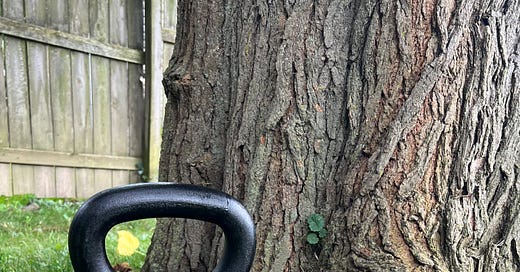The other night, in a home gym replete with barbells, dumbbells, bumper plates, a landmine attachment, slam-balls, and more… I found myself cranking out a single-kettlebell circuit.
“With access to so many tools,” some might wonder, “why limit yourself?”
This is a valid question. Surely certain pieces of equipment are more “optimal” for training certain muscle groups. And when it comes to single-implement workouts (e.g. one kettlebell, dumbbell, or sandbag) you may heard the criticism that “you shouldn’t squat the same weight that you press”, thereby limiting your ability to challenge stronger muscle groups, especially the lower body.
And yet, the vast majority of my strength training over the past year has been in what I would describe a minimalist format - a single or pair of kettlebells, push-up variations, pull-ups/inverted rows, a jumprope, and the occasional heavy sandbag.
First, a caveat: if your goal is to be as strong and muscular as absolutely possible, minimalist training is probably not for you. But if your goal is to be decently, even impressively fit, and to enjoy training in a flexible, sustainable manner - then keep reading. Here are some of my favorite benefits of minimalist training, as well as some tips for how to get the most from it.
Accessibility: No gym, no problem. With a minimalist approach you can skip the gym commute and crush a workout in your living room, basement, deck, backyard, or hotel room.
Efficiency: Again, bypassing the time spent driving, checking in, grabbing a locker, etc is a huge win - heck, you could have fit a whole workout in during that time! Instead, seize windows of time as they present themselves - naptime, right after the kids are down, or while they’re playing contentedly together. Minimalist equipment also lets you move seamlessly from exercise to exercise without changing weights, etc.
Affordability: Are kettlebells cheap? No - but they’re a great value for all the use you can get out of them (especially if you’re not paying gym dues!). A few hundred dollars is a no-brainer investment in your health and fitness.
Promotes creativity and a “can-do” attitude: Training with simple equipment teaches you to think outside the box in terms of exercise selection and workout programming. It is truly freeing to realize that you can come up with an effective workout anytime, anywhere! The ability to be your own coach and trainer is a huge step in taking lifelong ownership of your fitness. You will be well-equipped to handle periods in life when your usual routine is interrupted.
Learn to push your body + explore your limits: Applying the same weight/equipment to a variety of movements teaches you a lot about yourself. How many times can I squat this 50lb weight? Row it? Press it? What can I do to make this more challenging? Is it time to upgrade?
Meditative quality: less equipment means fewer distractions and interruptions. It becomes easier to lose yourself within a session.
The best part - getting outside!! I love taking my workout to the deck or backyard to soak up some sunshine and fresh air!
These are all great - but it does take smart programming to get maximum benefit from minimal equipment. Here are some tips.
Select an appropriate weight - something that will challenge both your upper and lower body. Muscles adapt to a relatively wide spectrum of reps - what is important is that you push yourself relatively close to failure with each set. An ideal weight might be something that you can overhead press (weaker movement) for sets of 6-ish reps, and squat for 15-ish reps (stronger movement, still working in a rep range that will build muscle).
Double up: training with a PAIR of dumbbells or kettlebells allows you to really crush your legs by doubling the load for movements like squats and lunges and reducing the gap between upper and lower body capacity.
Program appropriate lower body volume. Your legs are stronger than your upper body - to get the most from your workout with a fixed weight, you will need to include more reps per set, and/or include more exercises for your lower body than upper body. My full-body circuits often include an upper body push, an upper body pull, and TWO lower body movements (e.g. squats and lunges).
For medium weights, include unilateral and offset movements to increase difficulty. For example, my 28kg kettlebell is a little too light for me for goblet squats - but offset squats or suitcase lunges are more challenging movements with this weight.
For heavy weights. (e.g. a 100# sandbag), focus on lower body movements and incorporate push-ups (and pull-ups, if available) to hit your upper body.
Level up your push-ups: once you can do sets of 10-15+ pushups with good form, start including variations like dead-stop, feet-elevated, offset, and deficit push-ups to increase tension and range of motion.
In case you missed it, here is the workout I mentioned at the beginning of the article - it features some of my favorite simple yet effective exercises. Let me know if you give it a try!






Simplicity breeds creativity. My favorite part of training with my kettlebells at home is figuring out how to make moves more challenging. I find it really rewarding!